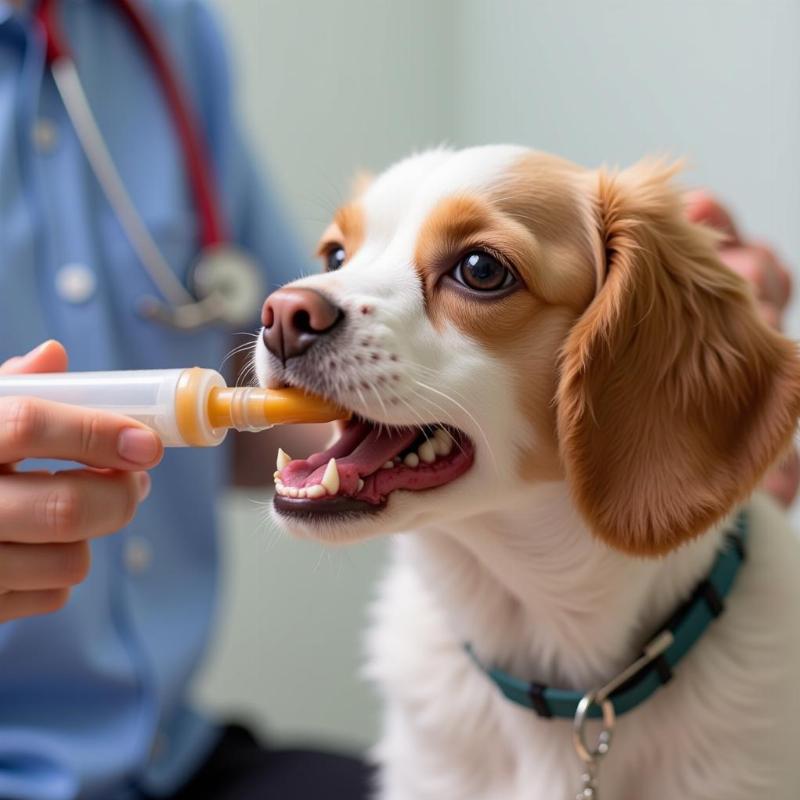A broken jaw in a dog is a serious injury that requires immediate veterinary care. Feeding a dog with this type of injury presents unique challenges and requires patience, understanding, and a modified approach to ensure they receive proper nutrition while healing. This article will guide you through the essential steps for feeding a dog with a broken jaw, focusing on techniques, nutritional needs, and ensuring a comfortable recovery.
Proper nutrition is vital for a dog’s healing process, especially when dealing with a broken jaw. While your veterinarian will provide specific instructions tailored to your dog’s situation, there are general guidelines to follow. You’ll likely need to switch to a soft food diet, or even a liquid diet, depending on the severity of the injury.  A dog with a broken jaw being fed soft food
A dog with a broken jaw being fed soft food
Understanding Your Dog’s Needs
A dog with a broken jaw will experience pain and discomfort, making eating a normal challenge. Therefore, understanding their specific needs and adjusting your approach is crucial. Start by consulting with your veterinarian for a personalized feeding plan. They will assess the severity of the fracture and recommend the most suitable diet and feeding methods.
Types of Food for a Dog with a Broken Jaw
Your vet might suggest several options depending on your dog’s individual case. These could include wet food, softened kibble, or even specially formulated liquid diets. In some cases, syringe feeding might be necessary.
Techniques for Feeding a Dog with a Broken Jaw
The feeding technique will depend on the severity of the fracture and your dog’s comfort level. Syringe feeding is often necessary for dogs with significant jaw immobility. 14 inch indestructible dog ball If your dog can lap, offer food in a shallow bowl. Remember to be patient and gentle throughout the process.
Syringe Feeding
Syringe feeding ensures your dog receives adequate nutrition when they can’t eat normally. Use a syringe without the needle and fill it with a blended mixture of their prescribed food and water. Gently insert the syringe into the side of their mouth and slowly dispense small amounts of food. can dogs eat beef neck bones Allow your dog time to swallow between each administration.
Assisted Feeding
If your dog can lap but struggles due to pain or limited movement, assist them by gently holding their head and supporting their jaw while they eat. This can provide stability and reduce discomfort.
Nutritional Considerations
Ensure your dog receives a balanced diet that meets their nutritional needs during recovery. how long does dog tooth extraction take] Your vet might recommend supplements to aid healing and support overall health. Monitor your dog’s weight and adjust the feeding plan accordingly.
Maintaining Hydration
Keeping your dog hydrated is crucial, especially when they’re on a soft or liquid diet. Offer fresh water frequently and ensure they have easy access to it.
Monitoring and Recovery
Regularly monitor your dog’s progress and consult with your veterinarian for any adjustments to the feeding plan. dog refuses to take pills] Healing time varies depending on the severity of the fracture. As your dog recovers, gradually transition them back to their regular diet under your vet’s guidance.
Conclusion
Feeding a dog with a broken jaw requires a delicate balance of patience, understanding, and proper technique. By following your veterinarian’s instructions and implementing the tips outlined in this article, you can ensure your furry friend receives the necessary nutrition for a comfortable and successful recovery. Remember to prioritize their comfort and well-being throughout the healing process. how to fix a dogs broken jaw at home
FAQ
- How long does it take for a dog’s broken jaw to heal? Healing time varies, typically ranging from several weeks to a few months, depending on the severity of the fracture and individual factors.
- What are the signs of a broken jaw in a dog? Common signs include swelling, pain, difficulty eating, drooling, and misalignment of the jaw.
- Can a dog’s broken jaw heal on its own? No, a broken jaw requires veterinary intervention for proper alignment and healing.
- What kind of surgery is needed for a broken jaw in a dog? The type of surgery depends on the fracture’s complexity, and may involve wiring, plating, or pinning the bones together.
- How can I prevent my dog from further injuring their jaw during recovery? Restrict their activity, use a muzzle if necessary to prevent chewing, and follow your vet’s instructions for pain management and physical therapy.
- What should I do if my dog refuses to eat with a broken jaw? Consult with your veterinarian immediately, as they may need to adjust the feeding plan or provide additional support.
- Are there any long-term effects of a broken jaw in a dog? In most cases, with proper care and rehabilitation, dogs recover fully. However, some dogs may experience minor changes in their bite or jaw movement.
Beautdogs.us is your premier source for all things dog-related in the US. We offer expert advice on dog breeds, care, and lifestyle, providing you with the resources you need to be the best dog parent possible. From puppyhood to senior years, we’re here to guide you every step of the way. Contact us at [email protected] or call +1 501-555-7529 for expert advice. Beautdogs.us is dedicated to helping you and your canine companion live a happy, healthy life together.